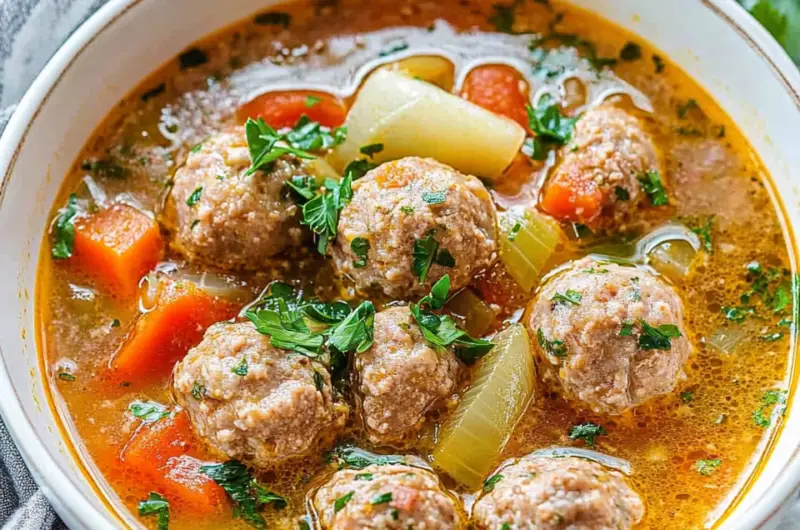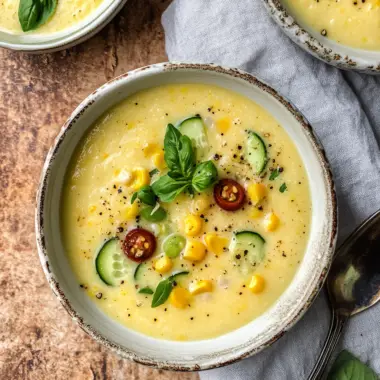The Romanian Meatball Soup, known as Ciorbă de Perișoare, is a beloved dish across Romania that exemplifies the heart of Eastern European comfort cuisine. A fragrant broth infused with root vegetables, acidic undertones from vinegar or lemon, and tender homemade meatballs makes this dish both hearty and refreshing. It’s often passed down from generation to generation as a symbol of hospitality and nourishment. This soup isn’t just another meal it’s a warm embrace in a bowl. With its rich yet light flavor profile, it suits both cold winter nights and lighter spring lunches. The combination of sweet vegetables and sour broth makes every spoonful intriguing. And the meatballs juicy and delicate are what elevate the dish from everyday to extraordinary.
Full Recipe:
Ingredients:
-
1 lb ground pork (or a mix of pork and beef)
-
1/4 cup rice
-
1 egg
-
1 small onion, finely chopped
-
2 carrots, diced
-
1 parsnip, diced
-
1 bell pepper, diced
-
1 small celery root, diced
-
6 cups water or broth
-
2 tablespoons tomato paste
-
2 tablespoons vinegar or lemon juice
-
1/4 cup chopped parsley
-
Salt and pepper to taste
-
2 tablespoons oil
Directions:
-
Mix the ground meat with rice, egg, salt, and pepper to form small meatballs. Set aside.
-
In a large pot, heat the oil and sauté the onion, carrots, parsnip, celery root, and bell pepper until slightly softened.
-
Add water or broth and bring to a boil.
-
Gently drop the meatballs into the simmering soup. Let cook on low heat for about 30 minutes.
-
Stir in tomato paste and vinegar or lemon juice to taste. Simmer for another 10 minutes.
-
Adjust salt and pepper. Garnish with fresh parsley and serve hot.
Prep Time: 15 minutes | Cooking Time: 40 minutes | Total Time: 55 minutes
Kcal: 295 kcal | Servings: 6 servings
Discovering the Heart of Romanian Cuisine: Ciorbă de Perișoare (Romanian Meatball Soup)
When it comes to Romanian culinary tradition, Ciorbă de Perișoare, or Romanian Meatball Soup, holds a place of deep cultural pride. It’s not merely a soup it’s a flavorful reflection of Romania’s agricultural abundance, regional ingredients, and deep-seated belief in hearty, comforting food that brings people together. This beloved sour meatball soup is a staple in households across Romania, often prepared for Sunday lunches, festive gatherings, and as a warm remedy during the colder months.
In Romanian cuisine, “ciorbă” refers to a specific type of soup one that is sour by design, typically enhanced with vinegar, lemon juice, or a fermented wheat bran solution called borș. The perișoare, or meatballs, are delicate, rice-studded spheres of seasoned ground pork (or a mix of pork and beef) that are gently poached in a vibrant vegetable broth. This dish is known for its beautiful balance between rich flavors and bright, zesty undertones.
Historical Roots and Regional Influences
Ciorbă de Perișoare is deeply rooted in Romania’s agricultural traditions and has long been a comfort food across generations. With strong influences from the Balkans, the Ottoman Empire, and Eastern Europe, Romanian cuisine has developed a unique identity, and this soup is a quintessential example.
The concept of sour soups can be traced across many cultures Poland’s żurek, Russia’s borscht, and Turkish ezogelin all share similar comforting profiles. What sets Ciorbă de Perișoare apart is its specific use of lightly seasoned meatballs with rice, a medley of garden vegetables, and a zingy finish from souring agents like vinegar or borș. These regional ingredients and cooking methods have evolved over time but remain firmly planted in tradition.
Each Romanian region puts its own spin on the soup. For example, in Moldova, it’s common to find dill or lovage added for an herby punch, while in Muntenia, tomato paste is more prevalent to deepen the broth’s color and flavor. Regardless of the variation, the soul of the dish stays consistent: warmth, comfort, and care in every bowl.
Why Ciorbă de Perișoare Stands Out
Unlike creamy or heavy soups, Ciorbă de Perișoare offers a lighter, more complex experience. The tanginess of the broth pairs incredibly well with the savory, tender meatballs, while the diced vegetables bring texture and earthy sweetness. It’s a one-pot meal that manages to be filling without feeling overly rich.
What also makes this soup so universally appealing is its adaptability. It can be made in large batches and stored for days without losing flavor. It’s friendly to substitutions ground chicken or turkey can be used in place of pork, and seasonal vegetables like zucchini, green beans, or leeks can be added without disrupting the balance of the dish.
For health-conscious cooks, this soup offers a nourishing, low-fat option packed with proteins, fibers, and vitamins. And since it doesn’t rely on dairy or processed ingredients, it easily fits into many diets, from gluten-free to Whole30, with only minor adjustments.
The Role of Sourness: A Balancing Act
One of the defining characteristics of this soup is its sour element. Romanian sour soups differ from others in their intentional use of acidic components to elevate and brighten the dish. This layer of flavor not only balances the richness of the meat but also activates the palate in a way that encourages appetite and digestion.
Borș, the fermented wheat bran liquid traditionally used to sour Romanian soups, is a probiotic-rich tonic that adds both flavor and health benefits. When borș isn’t available, cooks often substitute lemon juice or white vinegar, each bringing its own personality to the dish. This flexibility in the souring agent allows modern interpretations of the dish without straying too far from tradition.
A Dish for All Seasons
Ciorbă de Perișoare is enjoyed year-round in Romanian homes. In winter, it’s a belly-warming staple, often served with hot crusty bread or a dollop of sour cream. In spring and summer, it’s made lighter with more greens and herbs, becoming a refreshing yet hearty lunch option.
Its ability to adapt to seasonal ingredients makes it a rare recipe that remains relevant all year long. While some comfort foods are reserved for specific seasons, this soup seamlessly transitions from season to season, celebration to celebration.
Comfort Food With a Social Heart
More than just sustenance, Ciorbă de Perișoare carries emotional significance. It’s often described as a “mother’s soup” because of how commonly it’s made in Romanian households and how closely it’s associated with family care and affection. Many Romanians will tell you their first memory of this soup comes from their grandmother’s kitchen.
As such, the dish becomes a cultural connector. Whether shared at the family table, served at community events, or introduced to guests unfamiliar with Romanian cuisine, it always leaves a lasting impression. Its unique combination of homey warmth and bright, sophisticated flavor makes it approachable for both traditionalists and food adventurers alike.
Tips for Making the Perfect Ciorbă de Perișoare
While the recipe is straightforward, achieving the ideal flavor and texture requires attention to a few key details:
-
Use fresh, high-quality ingredients: The quality of your vegetables and meat will have a direct impact on the flavor of your broth and meatballs.
-
Don’t overmix the meatballs: Mix just enough to combine. Overworking the mixture can make the meatballs tough.
-
Add sour elements slowly: Taste as you go. Everyone’s preference for sourness is different, and you can always add more, but you can’t take it out.
-
Let the soup rest before serving: Like many soups and stews, the flavor of Ciorbă de Perișoare improves after it’s had time to sit. If you can, make it a few hours ahead or the night before.
Pairing and Serving Ideas
This soup is often enjoyed as a standalone dish, but it also pairs beautifully with fresh bread, especially Romanian pâine de casă (homemade bread). A side of pickled vegetables or a salad dressed with vinegar-based dressing can complement the sour profile of the soup. For a more indulgent touch, a spoonful of sour cream or a drizzle of chili oil can add creaminess and heat.
Wine lovers might consider a crisp white wine like Sauvignon Blanc or a dry Riesling to enhance the soup’s tangy edge. On a cozier note, a mug of plum brandy (țuică) or a slice of polenta can round out a traditional Romanian meal.
Conclusion:
Ciorbă de Perișoare isn’t just a dish it’s a taste of Romania’s heart and heritage. With each bite, you experience the comfort of home-cooked food, the bright zing of well-balanced flavors, and the cultural richness of a nation that values warmth, nourishment, and tradition.
Whether you’re exploring Romanian food for the first time or revisiting a childhood classic, this soup offers more than sustenance it offers a story. A story told through generations, from rustic kitchens in the Carpathians to modern stovetops across the globe.
As you prepare this soup in your own kitchen, know that you are carrying on a legacy. And in doing so, you’re not just feeding the body you’re nourishing the soul.








